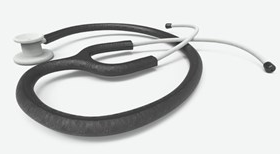Material scientists love to give their creations complex names. Polyethylene terephthalate (a form of polyester). Acrylonitrile butadiene styrene (you know this opaque thermoplastic better as ABS). These are just two examples of the thousands of polymers in use today. Many have profoundly changed our lives. One type of polymer, however, which bears no such lofty name, has been around far longer than its poly-syllabic counterparts. It’s durable, flexible, temperature resistant, biocompatible in many cases, and suitable for a variety of manufacturing processes, including injection molding and 3D printing. What is it? You probably know it best by its everyday moniker: rubber.
Types of Elastomers
Rubber is the stuff of tires, engine hoses, and more—but here we’re talking specifically about silicone rubber, which is technically a viscoelastic (short for viscous and elastic) polymer. Condense that term a bit more and you get elastomer. Elastomers are strong and (usually) flexible, and available in an array of grades that offer enhanced mechanical, chemical, and optical properties.
| INJECTION MOLDING | 3D PRINTING |
|---|---|
| LSR | Digital Photopolymers |
| LSR (Fluorosilicone) | TPU (also for injection molding) |
| LSR (Optical) | TPE/TPV |
| TPU (also for 3D printing) |
This design tip digs further into the details of using elastomers for designing parts that require flexibility, and also explores which manufacturing processes are applicable to each elastomer.
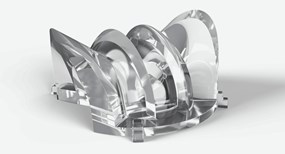
Elastomers for Injection Molding
If you’ve ever mixed up a little two-part epoxy for a household repair project, you’re already familiar with how liquid silicone rubber (LSR) parts are made. Using equipment similar to but in some ways the exact opposite of plastic injection molding, LSR molding forces equal parts of a chemical catalyst together with liquid silicone rubber into a chilled mixing chamber. From here it is injected into the mold cavity, which in the case of LSR is heated to speed the vulcanization process.
The design rules of LSR molding are quite forgiving. Worries over wall thickness, draft angles, undercuts, and corner radii can largely be tossed out the window. That’s because LSR has the consistency of water as it enters the mold—there are no problems with sink, knit lines, and voids at sharp corners or around deep ribs (assuming the mold has been properly gated and vented, of course). Nor is part ejection a problem—LSR parts generally remain flexible enough to pull from even the most straight-walled of molds. About the only thing designers need to be concerned with is flash—because LSR has such low viscosity, clean and consistent parting lines should be used wherever possible.
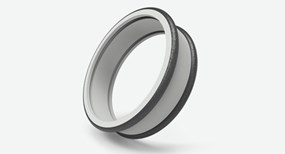
At FacFox, four types of LSRs are available. All play by the same basic set of design rules, but each offers fairly distinct characteristics:
- LSR—Elastosil LR 3003 series comes in five durometer levels, from 30 to 70 Shore A, and, like most LSRs, plays well with pigment. Suitable applications include automotive electrical components, seals and gaskets for the food industry, and anywhere a flexible, durable, temperature agnostic polymer is required.
- LSR (Fluorosilicone)—Silastic FL is very resistant to harsh environments. It’s a good choice for seals, gaskets, and membranes used around solvents and chemicals, or anywhere cold temperatures (down to -86°F) are a concern.
- LSR (Medical)—Dow Corning has developed its QP-1 LSR specifically for the medical industry. It’s a favorite for surgical and dental parts, health care products, and anywhere contact with humans is expected. QP-1 also demonstrates exceptional tear strength—up to 52.4 kN/M—the highest available at FacFox.
- LSR (Optical)—Need to make a clear but durable lens or other transparent part? Many injection molders might first opt for polycarbonate, but optical-grade LSR is eminently more moldable and has better optical qualities, second only to glass. It too is biocompatible, and at 72 Shore A ranks among the hardest of LSRs.
TPE and TPV materials are used regularly for those looking for molded elastomeric parts but they really come into play during two-material molding processes like overmolding. For instance, when you’re ready to take your PolyJet (3D printing) prototype to the next phase of development, FacFox offers many grades of elastomeric materials that all belong to the TPE/TPV (thermoplastic vulcanizate/thermoplastic elastomer) family. For example, Santoprene 111-45 TPV has excellent resistance to fatigue and would make a good cover for your smartphone. Similarly, Santoprene 101-73 works well for steering column boots and speaker surrounds.
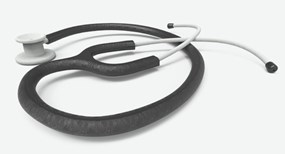
On the TPE end of the spectrum, Versaflex OM 1040X-1 has a soft feel, excellent aesthetic appearance (can be colored), and bonds well to polycarbonate or ABS, making it a good choice for gripping surfaces on medical devices. Another colorable TPE is Versaflex OM 6240-1, known for its affinity to nylon. And then there’s Hytrel 3078, which some might consider the Eveready bunny of elastomers thanks to its ability to flex, bend, and pull far longer than standard rubber material.
The design guidelines for all of these materials falls somewhere between the “almost anything goes” of LSR and those associated with traditional thermoplastics. When in doubt, upload your CAD model to FacFox automated quoting system and pay close attention to the resulting design for moldability analysis.
Elastomers for 3D Printing
PolyJet 3D printing uses a special type of “sprayable” liquid photopolymer with a hardness that can be tweaked on the fly and in the same build, making it a great choice for prototyping parts that will at some point be overmolded—a soft, grippable handle for a power tool, for example, or a weatherproof, gasketed cover for a scientific instrument housing. Digital photopolymers in white, black, and clear/translucent are available, and Shore A hardness levels range from 30 durometer to fully rigid. If you want to validate an overmold design, this is probably a good place to start, just be sure to check with FacFox that your 3D-printed part is also suitable for molding—some designers paint themselves into an additive manufacturing corner, only to find that their design can’t be manufactured en masse in a cost-effective manner.
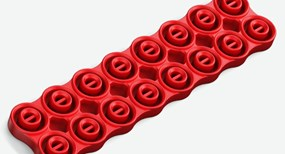
Until recently, another 3D printing process, selective laser sintering (SLS), was limited to nylon-like polymers in white, black, and glass-filled variants. That’s not a bad thing, but sometimes people want additional material choices, especially with an additive process as flexible and robust as SLS. Enter thermoplastic polyurethane, or TPU. In the plastic injection molding world, polyurethane is one of the go-to polymers, offering excellent mechanical properties, a wide hardness range and—depending on whether the TPU is polyester-based or polyether-based—a variety of desirable attributes including chemical, microbial, hydrolysis, and abrasion resistance.
That’s why FacFox now includes TPU—an elastomer that stretches with the best of them—in its lineup of SLS polymers. Need to prototype some ergonomic bicycle grips but don’t want to invest in a quick-turn mold? How about a set of strong and durable hoses for a packaging machine design? Go ahead and 3D print some samples. And even though the parts come out soft and flexible, there’s nothing especially different about the SLS process itself, so no need to learn a new set of design criteria. Again, upload the CAD file and review the design feedback.
As always, feel free to contact one of our application engineers with any questions at info@facfox.com.
